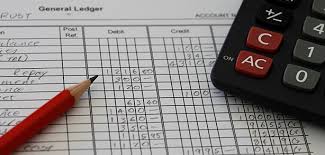How do you use a general ledger?
As a small business owner, you need to keep track of your company’s transactions. You can record transactions in a journal and ledger account. Making journal and ledger entries are important steps in accounting.
Journal entries
Every time you make a transaction for your business, you must record it. Transactions go through several steps in the accounting process.
First, you record transactions in a journal. A journal is used to identify transactions. Also known as the book of original entry, the journal is a running list of business transactions. Each line is a journal entry. Entries include the dates, descriptions, and amount of items bought or sold. Journals are separated into different accounts to stay organized. You will have five main accounts: assets, expenses, liabilities, revenue, and equity. Each of the main accounts can be divided into smaller subcategories. For example, you can break down assets into inventory and receivable categories.
If you use a double-entry bookkeeping system, you will also include a debit or credit. Debits and credits are equal but opposite entries. The debits and credits balance each other. Make one debit and one credit entry for each transaction.
Posting journal entries to general ledger accounts
After recording transactions in the journal, transfer them to the general ledger. You must post every transaction from your journal into the ledger. The ledger is the book of final entry. You use the ledger to organize and classify transactions. Each journal entry is moved into an individual account. The line items are called ledger entries.
Transfer the debit and credit amounts from the journal to the ledger account. After posting entries to the general ledger, calculate the balance of each account.
- Calculate the balance of an asset or expense account by subtracting the total credits from the total debits.
- Calculate the balance of a liability or equity account by subtracting the total debits from the total credits.
If you don’t want to balance accounts and calculate totals yourself, use basic accounting software to record transactions in your ledger. The software will automatically calculate totals for you.
Without software, you can record your ledger in a spreadsheet. However, this method could be time consuming and lead to more errors while posting to the ledger.

Ledger Accounts
There are five different categories the general ledger is broken down into, and these categories are known as “accounts.” The categories are:
1. Assets
Assets are any resources that are owned by the business and produce value. Assets can include cash, inventory, property, equipment, trademarks, and patents.
2. Liabilities
Liabilities are current or future financial debts the business has to pay. Current liabilities can include things like employee salaries and taxes, and future liabilities can include things like bank loans or lines of credit, and mortgages or leases.
3. Equity
Equity is the difference between the value of the assets and the liabilities of the business. If the business has more liabilities than assets, it can have negative equity. Equity can include things like common stock, stock options, or stocks, depending on if the company is privately or publicly owned by owners and/or shareholders.
4. Revenue
Revenue is the business’ income that is derived from the sales of its products and/or services. Revenue can include sales, interest, royalties, or any other fees the business collects from other individuals or businesses.
5. Expenses
Expenses consist of money paid by the business in exchange for a product or service. Expenses can include rent, utilities, travel, and meals.
The general ledger typically includes a front page that lists the names of the accounts documented within, and this list is known as the “chart of accounts.” The documentation of one account within the general ledger is referred to as an “account ledger.”

Double-Entry Accounting
There are two primary types of accounting methods. The single-account method works just fine if you’re a solopreneur. But, the double-entry accounting method makes it easier to prepare financial statements and improves accountability. So, switching to the double-entry accounting method may be wise.
Regardless of what you decide works for you and your small business, general ledgers use the double entry accounting method: An entry to one account requires an opposite entry to another account. Rephrased: every debit on one account has a credit on another.
A debit is an accounting entry that increases an asset or expense account and decreases a liabilities or owner’s equity account. A “credit” is the inverse.
Because credits and debits lead to the formation of an account that resembles the letter “T,” ledger accounts are also known as T accounts. You find debits on the left and credit on the right.
We’ll look at a few ledger examples shortly, but first, let’s review journals and the accounting equation.

Why the general ledger matters
There are two good reasons why the GL (as all the hip accountants call it) matters.
- It’s how you get financial statements
Financial statements help you track your business’s financial performance and cash flow. They draw on data compiled in the general ledger.
- There are three core types of financial statements useful to small business owners: the income statement, the balance sheet, and the cash flow statement. The general ledger matters because financial statements matter.
- You need it to file your taxes
You (or your accountant) need to refer to the general ledger in order to file your taxes. For instance, if you’re filing a Form 1099 for a contractor, you need to know how much you paid them during the financial year.
- In that case, checking your invoices against the general ledger will ensure you’re preparing the Form 1099 for them correctly.
- It gives you one place to view all your transactions
When you record a financial transaction, it’s called a journal entry, because bookkeeping has always been done by hand, in journals. Change is hard, so we still call them journal entries today.
- The general ledger is where you can see every journal entry ever made. Rather than having to comb through your bank statements, credit statements, and invoices when looking for one transaction, you can just check the general ledger and see your accounting records all in one place.
How to Develop Entries for the General Ledger
Because your business’s bookkeeping transactions are first entered into journals, you develop many of the entries for the General Ledger based on information pulled from the appropriate journal.
For example, cash receipts and the accounts that are impacted by those receipts are listed in the Cash Receipts journal. Cash disbursements and the accounts impacted by those disbursements are listed in the Cash Disbursements journal. The same is true for transactions found in the Sales journal, Purchases journal, General journal, and any other special journals you may be using.
At the end of each month, you summarize each journal by adding up the columns and then use that summary to develop an entry for the General Ledger. This takes a lot less time than entering every transaction in the General Ledger.
Cash Receipts journal entries
A Cash Receipts journal tracks transactions in which the business receives cash. In the following General Ledger entry, note that the debits and credits are in balance, at $2,900 each. All entries to the General Ledger must be balanced entries. That’s the cardinal rule of double-entry bookkeeping.
Account Debit Credit
Cash $2,900
Accounts Receivable $500
Sales $900
Capital $1,500
In this entry, the Cash account is increased by $2,900 to show that cash was received. The Accounts Receivable account is decreased by $500 to show customers paid their bills, and the money is no longer due. The Sales account is increased by $900, because additional revenue was collected. The Capital account is increased by $1,500 because the owner put more cash into the business.
Cash Disbursements journal entries
A Cash Disbursements journal keeps track of all cash transactions involving cash sent out of the business. The figure below shows how to summarize those transactions so they can be posted to the General Ledger. The following General Ledger entry is based on the transactions that appear in the Cash Disbursements journal in the figure.
Account Debit Credit
Rent $800
Accounts Payable $750
Salaries $350
Credit Card Payable $150
Cash $2,050
This General Ledger summary balances out at $2,050 each for the debits and credits. The Cash account is decreased to show the cash outlay, the Rent and Salaries expense accounts are increased to show the additional expenses, and the Accounts Payable and Credit Card Payable accounts are decreased to show that bills were paid and are no longer due.
Sales journal entries
A Sales journal keeps track of all sales transactions. The figure below shows how to summarize those transactions so they can be posted to the General Ledger. The following General Ledger entry is based on the transactions that appear in the Sales journal in the figure.
Account Debit Credit
Accounts Receivable $800
Sales $800
Note that this entry is balanced. The Accounts Receivable account is increased to show that customers owe the business money because they bought items on store credit. The Sales account is increased to show that even though no cash changed hands, the business took in revenue. Cash will be collected when the customers pay their bills.
Purchases journal entries
A Purchases journal keeps track of all purchases of goods to be sold. The figure below shows how to summarize those transactions so they can be posted to the General Ledger. The following General Ledger entry is based on the transactions that appear in the Purchases journal in the figure.
Account Debit Credit
Purchases $925
Accounts Payable $925
Like the entry for the Sales account, this entry is balanced. The Accounts Payable account is increased to show that money is due to vendors, and the Purchases expense account is also increased to show that more supplies were purchased.
General journal entries
A General journal keeps track of all miscellaneous transactions that are not tracked in a specific journal, such as a Sales journal or a Purchases journal. The figure below shows how to summarize those transactions so they can be posted to the General Ledger. The following General Ledger entry is based on the transactions that appear in the General journal in the figure.
Account Debit Credit
Sales Return $60
Accounts Payable $200
Vehicles $10,000
Accounts Receivable $60
Purchase Return $200
Capital $10,000
Checking for balance — Debits and credits both total to $10,260. In this entry, the Sales Return and Purchase Return accounts are increased to show additional returns. The Accounts Payable and Accounts Receivable accounts are both decreased to show that money is no longer owed. The Vehicles account is increased to show new company assets, and the Capital account, which is where the owner’s deposits into the business are tracked, is increased accordingly.